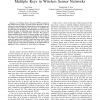GLOBECOM
2007
IEEE
14 years 5 months ago
2007
IEEE
Abstract— We study transmission schemes for lifetime maximization in wireless sensor networks. Specifically we consider the network where all the sensors observe uncorrelated si...
GLOBECOM
2007
IEEE
14 years 5 months ago
2007
IEEE
— An opportunistic large array (OLA) is a form of cooperative diversity in which a large group of simple, inexpensive relays or forwarding nodes operate without any mutual coordi...
GLOBECOM
2007
IEEE
14 years 5 months ago
2007
IEEE
— Energy-ef ciency is one of the major concerns in wireless sensor networks since it impacts the network lifetime. In this paper, we investigate the relationship between sensor n...
GLOBECOM
2007
IEEE
14 years 5 months ago
2007
IEEE
— In Wireless Sensor Networks (WSNs), symmetric key schemes may be used to provide security. Recently, a class of random key pre-distribution techniques have been proposed and in...
GLOBECOM
2007
IEEE
14 years 5 months ago
2007
IEEE
Abstract— Enhancing the connectivity of wireless sensor networks is necessary to avoid the occurrence of coverage gaps. In this paper, we aim at improving the network connectivit...
FBIT
2007
IEEE
14 years 5 months ago
2007
IEEE
In Wireless Sensor Networks (WSNs), address-based routing approaches often lead to severe problems due to node mobility, energy-saving sleep-cycles, and often missing or unreliabl...
DSD
2007
IEEE
14 years 5 months ago
2007
IEEE
Abstract—Localization is one of the most challenging and important issues in wireless sensor networks (WSNs), especially if cost-effective approaches are demanded. In this paper,...
DASFAA
2007
IEEE
14 years 5 months ago
2007
IEEE
Networks of thousands of sensors present a feasible and economic solution to some of our most challenging problems, such as real-time traffic modeling, military sensing and trackin...
COMSWARE
2007
IEEE
14 years 5 months ago
2007
IEEE
Abstract— Wireless sensor networks consist of small, inexpensive devices which interact with the environment, communicate with each other, and perform distributed computations in...
COMSWARE
2007
IEEE
14 years 5 months ago
2007
IEEE
— Wireless sensor networks have attracted significant interest for various scientific, military, and e-health applications. Recently a new class of sensor networks “sensor/ac...

